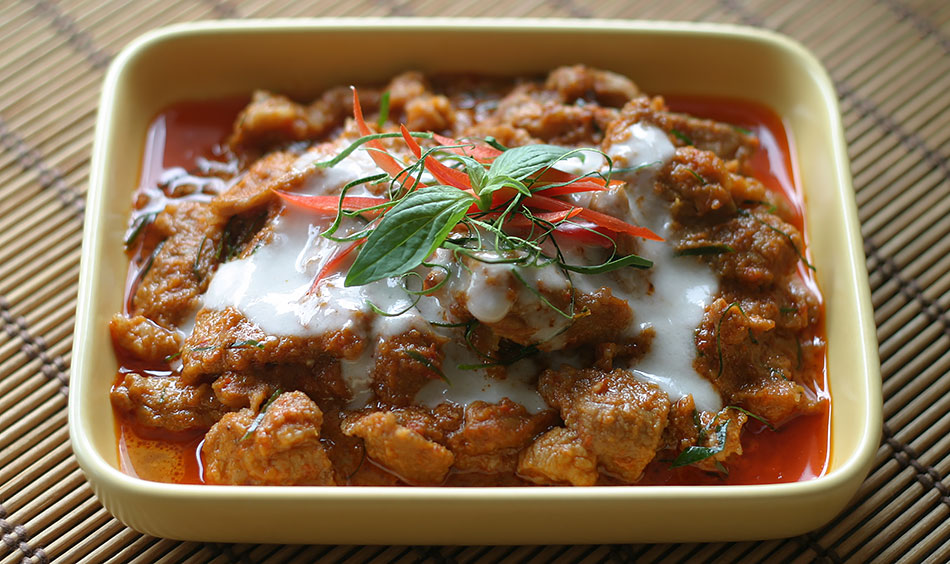
Panang Curry
Panang Curry (sometimes written Penang Curry) is a dry curry which is fried in coconut milk, and not boiled. Panang uses the thicker part of the milk, or the cream only. It’s typically made with beef, although you can make it with pork or chicken as well. It is usually just meat, and is seasoned with sliced lime leaves and sometimes a few leaves of Thai basil.
Ingredients
- 2 cups homemade (or 1 can) coconut milk
- 1 tablespoon shredded lime leaves
- 1/2 teaspoon palm sugar
- 2 cups sliced beef or pork
- 2 tablespoons fish sauce
Curry Paste
- 1/3 cup large dried chilies, soaked until soft with seeds removed
- 1 teaspoon salt
- 2 teaspoons galangal, cut into matchsticks
- 2 tablespoons lemongrass, cut into thin rounds
- 1 tablespoon :cilantro root:
- 1 teaspoon toasted coriander seeds
- 1 teaspoon toasted cumin seeds
- 2 tablespoons garlic
- 2 tablespoons shallots
- 1 tablespoon roasted peanuts
- 1 teaspoon shrimp paste
Directions
- The first step is to make the curry paste. Start by soaking the chilies in water until they’re soft. This could take up to a half hour. When they’re soft, cut them open to remove the guts & seeds.
- Toast the cumin seeds, cilantro seeds and peanuts separately in a pan over medium heat. Roast each until fragrant, about 3-5 minutes.
- Grind up the seeds together in a stone mortar and pestle until powdered. Remove and set aside.
- Add your chilies with the salt to the stone mortar and pestle and pound until a paste. This will take awhile — the skins are difficult to mash. Be patient.
- When your chilies are a uniform paste, add the lemongrass. Pound until a paste. Then add the galangal and coriander roots, and again, smash until paste.
- Add the peanuts, shallots, garlic and your powdered cumin & cilantro seeds. Mash until paste. Add the shrimp paste and pound to mix well. Set aside.
- Cut your meat cross-grain into thin slices (about 1.5″ (4cm) long x 1/2″ (1.25cm) tall x 1/8″ (.25cm) thick).
- Now, on to frying your curry! Heat up your pan first on medium-high heat, then add 1/2 cup of the coconut cream. It should sizzle right away and boil. Add all the paste and mix well.
- Fry the paste. You want to keep the paste dry, but not too dry that it sticks and burns. Keep adding a little bit of coconut milk when it gets too dry, maybe about 1/4 cup every minute or two. Keep stirring so it doesn’t burn.
- Keep adding coconut cream about 1/4 cup at a time, every minute or two. You should start to see a lot of oil coming to the top of the curry. This is normal and a sign that you’re doing it right!
- Your paste should start to smell really good after 4-5 minutes. You’ll start to see a lot of oil rising to the top, especially where it’s bubbling. When it does, add your meat.
- Cook the meat until cooked, add the lime leaves, fish sauce and palm sugar, then keep going about 3-5 minutes so the meat is soft. The consistency of the curry should be similar to the photo. If it’s too dry, add a bit more of the coconut milk. Remove and serve.
- Feel free to garnish with shredded lime leaves and a few leaves of Thai basil. Some fancy restaurants serve it like shown with a bit of thickened coconut cream (thickened with a bit of tapioca flour) which you’re welcome to do too!
Note:
Panang Curry should be dry and thick like this, and not soupy like red or green curries. While Panang is usually made with meat, some restaurants serve Panang with shrimp. It's up to you!
If you'd like your Panang curry to be a bit hotter, try adding some :small dried chilies: in with your paste.
Slicing the meat thin like this allows the meat to get soft and absorb the flavor quicker.























